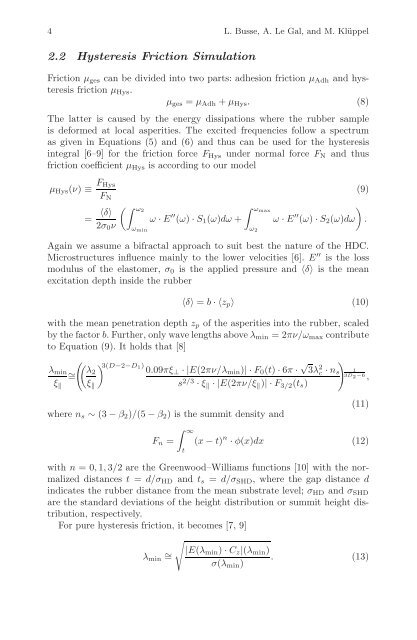- Page 2 and 3: Lecture Notes in Applied and Comput
- Page 4 and 5: Elastomere Friction Theory, Experim
- Page 6 and 7: Preface Understanding elastomer fri
- Page 8 and 9: Contents Modelling of Dry and Wet F
- Page 10 and 11: 2 L.Busse,A.LeGal,andM.Klüppel of
- Page 14 and 15: 6 L.Busse,A.LeGal,andM.Klüppel 3 E
- Page 16 and 17: 8 L.Busse,A.LeGal,andM.Klüppel Tab
- Page 18 and 19: 10 L.Busse,A.LeGal,andM.Klüppel Fi
- Page 20 and 21: 12 L.Busse,A.LeGal,andM.Klüppel Fi
- Page 22 and 23: 14 L.Busse,A.LeGal,andM.Klüppel Fi
- Page 24 and 25: 16 L.Busse,A.LeGal,andM.Klüppel 4.
- Page 26 and 27: 18 L.Busse,A.LeGal,andM.Klüppel Ta
- Page 28 and 29: 20 L.Busse,A.LeGal,andM.Klüppel Fi
- Page 30 and 31: 22 L.Busse,A.LeGal,andM.Klüppel Fi
- Page 32 and 33: 24 L.Busse,A.LeGal,andM.Klüppel co
- Page 34 and 35: 26 L.Busse,A.LeGal,andM.Klüppel 16
- Page 36 and 37: 28 H.Lorenz,J.Meier,andM.Klüppel F
- Page 38 and 39: 30 H.Lorenz,J.Meier,andM.Klüppel I
- Page 40 and 41: 32 H.Lorenz,J.Meier,andM.Klüppel A
- Page 42 and 43: 34 H.Lorenz,J.Meier,andM.Klüppel A
- Page 44 and 45: 36 H.Lorenz,J.Meier,andM.Klüppel B
- Page 46 and 47: 38 H.Lorenz,J.Meier,andM.Klüppel F
- Page 48 and 49: 40 H.Lorenz,J.Meier,andM.Klüppel s
- Page 50 and 51: 42 H.Lorenz,J.Meier,andM.Klüppel F
- Page 52 and 53: 44 H.Lorenz,J.Meier,andM.Klüppel F
- Page 54 and 55: 46 H.Lorenz,J.Meier,andM.Klüppel F
- Page 56 and 57: 48 H.Lorenz,J.Meier,andM.Klüppel e
- Page 58 and 59: 50 H.Lorenz,J.Meier,andM.Klüppel F
- Page 60 and 61: 52 H.Lorenz,J.Meier,andM.Klüppel 9
- Page 62 and 63:
54 J. Reinelt and P. Wriggers of th
- Page 64 and 65:
56 J. Reinelt and P. Wriggers 2 Mul
- Page 66 and 67:
58 J. Reinelt and P. Wriggers 1μm
- Page 68 and 69:
60 J. Reinelt and P. Wriggers frict
- Page 70 and 71:
62 J. Reinelt and P. Wriggers Modul
- Page 72 and 73:
64 J. Reinelt and P. Wriggers Cz 2a
- Page 74 and 75:
66 J. Reinelt and P. Wriggers 0.6 0
- Page 76 and 77:
68 J. Reinelt and P. Wriggers disti
- Page 78 and 79:
70 J. Reinelt and P. Wriggers A sui
- Page 80 and 81:
72 J. Reinelt and P. Wriggers 0.25
- Page 82 and 83:
74 J. Reinelt and P. Wriggers Table
- Page 84 and 85:
76 J. Reinelt and P. Wriggers Thus
- Page 86 and 87:
78 J. Reinelt and P. Wriggers exper
- Page 88 and 89:
80 J. Reinelt and P. Wriggers F = 1
- Page 90 and 91:
82 J. Reinelt and P. Wriggers Fig.
- Page 92 and 93:
84 J. Reinelt and P. Wriggers adhes
- Page 94 and 95:
86 J. Reinelt and P. Wriggers stres
- Page 96 and 97:
88 J. Reinelt and P. Wriggers 8 The
- Page 98 and 99:
90 J. Reinelt and P. Wriggers frict
- Page 100 and 101:
92 J. Reinelt and P. Wriggers cause
- Page 102 and 103:
94 J. Reinelt and P. Wriggers 28. O
- Page 104 and 105:
96 D. Besdo, N. Gvozdovskaya, and K
- Page 106 and 107:
98 D. Besdo, N. Gvozdovskaya, and K
- Page 108 and 109:
100 D. Besdo, N. Gvozdovskaya, and
- Page 110 and 111:
102 D. Besdo, N. Gvozdovskaya, and
- Page 112 and 113:
104 D. Besdo, N. Gvozdovskaya, and
- Page 114 and 115:
106 D. Besdo, N. Gvozdovskaya, and
- Page 116 and 117:
108 D. Besdo, N. Gvozdovskaya, and
- Page 118 and 119:
110 D. Besdo, N. Gvozdovskaya, and
- Page 120 and 121:
112 D. Besdo, N. Gvozdovskaya, and
- Page 122 and 123:
114 D. Besdo, N. Gvozdovskaya, and
- Page 124 and 125:
116 D. Besdo, N. Gvozdovskaya, and
- Page 126 and 127:
118 D. Besdo, N. Gvozdovskaya, and
- Page 128 and 129:
120 D. Besdo, N. Gvozdovskaya, and
- Page 130 and 131:
Finite Element Techniques for Rolli
- Page 132 and 133:
Finite Element Techniques for Rolli
- Page 134 and 135:
Finite Element Techniques for Rolli
- Page 136 and 137:
Finite Element Techniques for Rolli
- Page 138 and 139:
Finite Element Techniques for Rolli
- Page 140 and 141:
Finite Element Techniques for Rolli
- Page 142 and 143:
Finite Element Techniques for Rolli
- Page 144 and 145:
Finite Element Techniques for Rolli
- Page 146 and 147:
Finite Element Techniques for Rolli
- Page 148 and 149:
Finite Element Techniques for Rolli
- Page 150 and 151:
Finite Element Techniques for Rolli
- Page 152 and 153:
Finite Element Techniques for Rolli
- Page 154 and 155:
Finite Element Techniques for Rolli
- Page 156 and 157:
Finite Element Techniques for Rolli
- Page 158 and 159:
Finite Element Techniques for Rolli
- Page 160 and 161:
Finite Element Techniques for Rolli
- Page 162 and 163:
Finite Element Techniques for Rolli
- Page 164 and 165:
Finite Element Techniques for Rolli
- Page 166 and 167:
Finite Element Techniques for Rolli
- Page 168 and 169:
Finite Element Techniques for Rolli
- Page 170 and 171:
Finite Element Techniques for Rolli
- Page 172 and 173:
166 P. Moldenhauer and M. Kröger o
- Page 174 and 175:
168 P. Moldenhauer and M. Kröger F
- Page 176 and 177:
170 P. Moldenhauer and M. Kröger C
- Page 178 and 179:
172 P. Moldenhauer and M. Kröger 2
- Page 180 and 181:
174 P. Moldenhauer and M. Kröger S
- Page 182 and 183:
176 P. Moldenhauer and M. Kröger
- Page 184 and 185:
178 P. Moldenhauer and M. Kröger T
- Page 186 and 187:
180 P. Moldenhauer and M. Kröger N
- Page 188 and 189:
182 P. Moldenhauer and M. Kröger c
- Page 190 and 191:
184 P. Moldenhauer and M. Kröger C
- Page 192 and 193:
186 P. Moldenhauer and M. Kröger N
- Page 194 and 195:
188 P. Moldenhauer and M. Kröger i
- Page 196 and 197:
190 P. Moldenhauer and M. Kröger C
- Page 198 and 199:
192 P. Moldenhauer and M. Kröger F
- Page 200 and 201:
194 P. Moldenhauer and M. Kröger F
- Page 202 and 203:
196 P. Moldenhauer and M. Kröger C
- Page 204 and 205:
198 P. Moldenhauer and M. Kröger A
- Page 206 and 207:
200 P. Moldenhauer and M. Kröger 3
- Page 208 and 209:
202 N. Bouzid and B. Heimann Fig. 1
- Page 210 and 211:
204 N. Bouzid and B. Heimann Fig. 2
- Page 212 and 213:
206 N. Bouzid and B. Heimann Fig. 4
- Page 214 and 215:
208 N. Bouzid and B. Heimann Fig. 5
- Page 216 and 217:
210 N. Bouzid and B. Heimann Fig. 7
- Page 218 and 219:
212 N. Bouzid and B. Heimann Table
- Page 220 and 221:
214 N. Bouzid and B. Heimann Fig. 1
- Page 222 and 223:
216 N. Bouzid and B. Heimann Fig. 1
- Page 224 and 225:
218 N. Bouzid and B. Heimann Fig. 1
- Page 226 and 227:
220 N. Bouzid and B. Heimann the ma
- Page 228 and 229:
222 F. Gutzeit and M. Kröger Fig.
- Page 230 and 231:
224 F. Gutzeit and M. Kröger Fig.
- Page 232 and 233:
226 F. Gutzeit and M. Kröger satur
- Page 234 and 235:
228 F. Gutzeit and M. Kröger Fig.
- Page 236 and 237:
230 F. Gutzeit and M. Kröger displ
- Page 238 and 239:
232 F. Gutzeit and M. Kröger emana
- Page 240 and 241:
234 F. Gutzeit and M. Kröger Fig.
- Page 242 and 243:
236 F. Gutzeit and M. Kröger coord
- Page 244 and 245:
238 F. Gutzeit and M. Kröger ident
- Page 246 and 247:
240 F. Gutzeit and M. Kröger Fig.
- Page 248 and 249:
242 F. Gutzeit and M. Kröger Fig.
- Page 250 and 251:
244 F. Gutzeit and M. Kröger Fig.
- Page 252 and 253:
246 F. Gutzeit and M. Kröger Fig.
- Page 254 and 255:
248 F. Gutzeit and M. Kröger The c
- Page 256:
Author Index Besdo, D. 95 Bouzid, N









